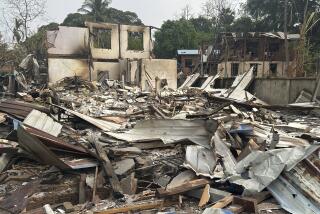Manila, Rebels Step Up Their 19-Year Conflict
- Share via
MANILA — The Communist guerrilla army marked its 19th anniversary Tuesday amid a wave of killings, kidnapings and ambushes that analysts and senior military commanders say represents a nationwide intensification of the Philippine war by both rebel and government forces.
In the days leading up to the anniversary, the Communist New People’s Army has kidnaped or killed dozens of police officers, soldiers and government officials, including a daring ambush Monday in Manila that may signal a new sophistication in their tactics.
But the government, too, has used the rebel anniversary to go on the offensive against a rebellion that already has left thousands dead and has strained the Philippine armed forces to its limits.
Top Officials Captured
Today, the victory appeared to belong to the government. High-ranking military officials announced that police had captured two top Philippine Communist Party officials and a senior commander of the New People’s Army during a raid on a home in Manila Tuesday. At a press conference today, the armed forces presented the prisoners: General Secretary Rafael Baylosis, Central Committee member Benjamin De Vera and Romulo Kintanar, head of the central military staff of the New People’s Army.
Analysts monitoring the 25,000-member rebel movement said the capture of the three dealt a severe blow to the Communist hierarchy here.
Armed Forces Chief Renato de Villa told reporters Tuesday night that the arrests were the result of “intensive intelligence work” and should stand as proof to Manila residents that the armed forces can protect them.
“Instead of just arresting the little Indians doing the killings, we arrested the leaders,” Brig. Gen. Alexander Aguirre, commander of the national police in Manila, declared late Tuesday as he left President Corazon Aquino’s office in the presidential palace.
At the same time, Philippine army and national police combat units recently have intensified their patrols in rural villages where the Communists are strongest. The government’s escalation in operations has triggered an unprecedented number of gun battles with the rebels in mountain jungles.
For the last year, key military strategists also have been preparing a new counterinsurgency strategy tailored specifically to the guerrilla war, which now rages in all but a handful of the Philippines’ 73 scattered rural provinces.
Since the New People’s Army began its rebellion in 1969 as a few dozen idealistic students, the army has relied almost entirely on the “low-intensity conflict” strategies designed by Washington during the Vietnam War.
“It’s clear that those strategies don’t work--you lost,” one army colonel said in an interview last week. “What we are doing is reshaping our entire counterinsurgency effort to better fit the situation we are facing in the Philippines today.”
Will Be Implemented Soon
The new strategy, to be implemented in the coming months, targets 15 to 20 of the provinces where military intelligence officials say the New People’s Army is strongest and would call for localized operations of up to two years.
But as the government escalates its campaign, the New People’s Army, under the leadership of several new, young, militant commanders, also has decided to intensify its armed struggle.
In recent interviews, Philippine military and rebel leaders alike have confirmed U.S. intelligence reports that the New People’s Army has been attempting to make a major arms purchase on the international market for the first time since the early 1970s.
Such a purchase could radically shift the initiative in the war, analysts say. Because of a shortage of weapons, less than two-thirds of the members of the New People’s Army are armed at any given time.
More to Read
Sign up for Essential California
The most important California stories and recommendations in your inbox every morning.
You may occasionally receive promotional content from the Los Angeles Times.













